diff options
| author | Joel Hans <joel@netdata.cloud> | 2020-01-14 03:50:10 +0200 |
|---|---|---|
| committer | Chris Akritidis <43294513+cakrit@users.noreply.github.com> | 2020-01-14 03:50:10 +0200 |
| commit | ed0da165aa6152e2d0bf01707e0814bb2d620e65 (patch) | |
| tree | 3d2e4b21e83d96bc89406378b74b476772a23992 /README.md | |
| parent | aabb68d2907bc8b83b0dd376d32269bcb18b1b9d (diff) | |
Docs: Linter fixes for main README (#7526)
* Linter fix pass
* Fixing last emphasis
Diffstat (limited to 'README.md')
| -rw-r--r-- | README.md | 405 |
1 files changed, 258 insertions, 147 deletions
@@ -1,12 +1,25 @@ # Netdata [](https://travis-ci.com/netdata/netdata) [](https://bestpractices.coreinfrastructure.org/projects/2231) [](https://www.gnu.org/licenses/gpl-3.0) [](<>) -[](https://codeclimate.com/github/netdata/netdata) [](https://www.codacy.com/app/netdata/netdata?utm_source=github.com&utm_medium=referral&utm_content=netdata/netdata&utm_campaign=Badge_Grade) [](https://lgtm.com/projects/g/netdata/netdata/context:cpp) [](https://lgtm.com/projects/g/netdata/netdata/context:javascript) [](https://lgtm.com/projects/g/netdata/netdata/context:python) +[](https://codeclimate.com/github/netdata/netdata) +[](https://www.codacy.com/app/netdata/netdata?utm_source=github.com&utm_medium=referral&utm_content=netdata/netdata&utm_campaign=Badge_Grade) +[](https://lgtm.com/projects/g/netdata/netdata/context:cpp) +[](https://lgtm.com/projects/g/netdata/netdata/context:javascript) +[](https://lgtm.com/projects/g/netdata/netdata/context:python) --- -**Netdata** is **distributed, real-time, performance and health monitoring for systems and applications**. It is a highly-optimized monitoring agent you install on all your systems and containers. +**Netdata** is **distributed, real-time, performance and health monitoring for systems and applications**. It is a +highly-optimized monitoring agent you install on all your systems and containers. -Netdata provides **unparalleled insights**, **in real-time**, of everything happening on the systems it runs (including web servers, databases, applications), using **highly interactive web dashboards**. It can run autonomously, without any third-party components, or it can be integrated to existing monitoring toolchains (Prometheus, Graphite, OpenTSDB, Kafka, Grafana, and more). +Netdata provides **unparalleled insights**, **in real-time**, of everything happening on the systems it runs (including +web servers, databases, applications), using **highly interactive web dashboards**. It can run autonomously, without any +third-party components, or it can be integrated to existing monitoring toolchains (Prometheus, Graphite, OpenTSDB, +Kafka, Grafana, and more). Netdata is **fast** and **efficient**, designed to permanently run on all systems (**physical** & **virtual** servers, **containers**, **IoT** devices), without disrupting their core function. @@ -14,7 +27,8 @@ Netdata is **fast** and **efficient**, designed to permanently run on all system Netdata is **free, open-source software** and it currently runs on **Linux**, **FreeBSD**, and **MacOS**, along with other systems derived from them, such as **Kubernetes** and **Docker**. -Netdata is not hosted by the CNCF but is the 3rd most starred open-source project in the [Cloud Native Computing Foundation (CNCF) landscape](https://landscape.cncf.io/format=card-mode&grouping=no&sort=stars). +Netdata is not hosted by the CNCF but is the 3rd most starred open-source project in the [Cloud Native Computing +Foundation (CNCF) landscape](https://landscape.cncf.io/format=card-mode&grouping=no&sort=stars). --- @@ -22,7 +36,8 @@ People get **addicted to Netdata**. Once you use it on your systems, **there is  -[](https://twitter.com/intent/tweet?text=Netdata,%20real-time%20performance%20and%20health%20monitoring,%20done%20right!&url=https://my-netdata.io/&via=linuxnetdata&hashtags=netdata,monitoring) +[](https://twitter.com/intent/tweet?text=Netdata,%20real-time%20performance%20and%20health%20monitoring,%20done%20right!&url=https://my-netdata.io/&via=linuxnetdata&hashtags=netdata,monitoring) ## Contents @@ -46,42 +61,61 @@ People get **addicted to Netdata**. Once you use it on your systems, **there is The following animated GIF shows the top part of a typical Netdata dashboard. -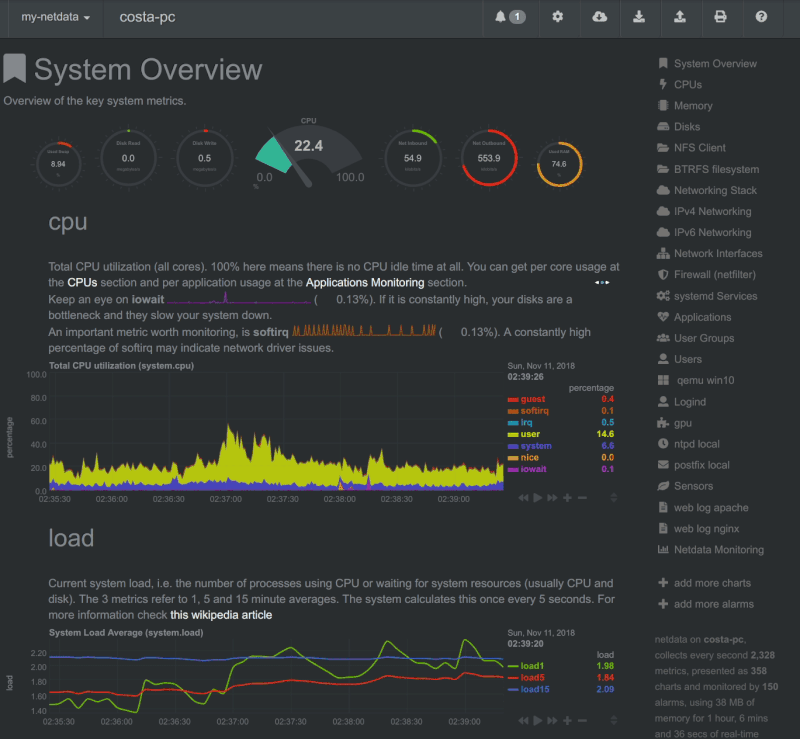 + > A typical Netdata dashboard, in 1:1 timing. Charts can be panned by dragging them, zoomed in/out with `SHIFT` + `mouse -> wheel`, an area can be selected for zoom-in with `SHIFT` + `mouse selection`. Netdata is highly interactive, +> wheel`, an area can be selected for zoom-in with `SHIFT` + `mouse selection`. Netdata is highly interactive, > **real-time**, and optimized to get the work done! Want to see Netdata live? Check out any of our [live demos](https://www.netdata.cloud/#live-demo). ## User base -Netdata is used by hundreds of thousands of users all over the world. -Check our [GitHub watchers list](https://github.com/netdata/netdata/watchers). -You will find people working for **Amazon**, **Atos**, **Baidu**, **Cisco Systems**, **Citrix**, **Deutsche Telekom**, **DigitalOcean**, -**Elastic**, **EPAM Systems**, **Ericsson**, **Google**, **Groupon**, **Hortonworks**, **HP**, **Huawei**, -**IBM**, **Microsoft**, **NewRelic**, **Nvidia**, **Red Hat**, **SAP**, **Selectel**, **TicketMaster**, -**Vimeo**, and many more! +Netdata is used by hundreds of thousands of users all over the world. Check our [GitHub watchers +list](https://github.com/netdata/netdata/watchers). You will find people working for **Amazon**, **Atos**, **Baidu**, +**Cisco Systems**, **Citrix**, **Deutsche Telekom**, **DigitalOcean**, **Elastic**, **EPAM Systems**, **Ericsson**, +**Google**, **Groupon**, **Hortonworks**, **HP**, **Huawei**, **IBM**, **Microsoft**, **NewRelic**, **Nvidia**, **Red +Hat**, **SAP**, **Selectel**, **TicketMaster**, **Vimeo**, and many more! ### Docker pulls We provide Docker images for the most common architectures. These are statistics reported by Docker Hub: -[](https://hub.docker.com/r/netdata/netdata/) [](https://hub.docker.com/r/firehol/netdata/) [](https://hub.docker.com/r/titpetric/netdata/) +[](https://hub.docker.com/r/netdata/netdata/) +[](https://hub.docker.com/r/firehol/netdata/) +[](https://hub.docker.com/r/titpetric/netdata/) ### Registry -When you install multiple Netdata, they are integrated into **one distributed application**, via a [Netdata registry](registry/README.md). This is a web browser feature and it allows us to count the number of unique users and unique Netdata servers installed. The following information comes from the global public Netdata registry we run: +When you install multiple Netdata, they are integrated into **one distributed application**, via a [Netdata +registry](registry/README.md). This is a web browser feature and it allows us to count the number of unique users and +unique Netdata servers installed. The following information comes from the global public Netdata registry we run: -[](https://registry.my-netdata.io/#menu_netdata_submenu_registry) [](https://registry.my-netdata.io/#menu_netdata_submenu_registry) [](https://registry.my-netdata.io/#menu_netdata_submenu_registry) +[](https://registry.my-netdata.io/#menu_netdata_submenu_registry) +[](https://registry.my-netdata.io/#menu_netdata_submenu_registry) +[](https://registry.my-netdata.io/#menu_netdata_submenu_registry) -_In the last 24 hours:_<br/> [](https://registry.my-netdata.io/#menu_netdata_submenu_registry) [](https://registry.my-netdata.io/#menu_netdata_submenu_registry) [](https://registry.my-netdata.io/#menu_netdata_submenu_registry) +_In the last 24 hours:_<br/> [](https://registry.my-netdata.io/#menu_netdata_submenu_registry) +[](https://registry.my-netdata.io/#menu_netdata_submenu_registry) +[](https://registry.my-netdata.io/#menu_netdata_submenu_registry) ## Quickstart -  + + -To install Netdata from source on any Linux system (physical, virtual, container, IoT, edge) and keep it up to date with our **nightly releases** automatically, run the following: +To install Netdata from source on any Linux system (physical, virtual, container, IoT, edge) and keep it up to date with +our **nightly releases** automatically, run the following: ```bash # make sure you run `bash` for your shell @@ -97,7 +131,7 @@ about the information collected, and learn how to-opt, on our [anonymous statist The usage statistics are _vital_ for us, as we use them to discover bugs and priortize new features. We thank you for _actively_ contributing to Netdata's future. -To learn more about the pros and cons of using *nightly* vs. *stable* releases, see our [notice about the two options](packaging/installer/README.md#nightly-vs-stable-releases). +To learn more about the pros and cons of using _nightly_ vs. _stable_ releases, see our [notice about the two options](packaging/installer/README.md#nightly-vs-stable-releases). The above command will: @@ -106,8 +140,6 @@ The above command will: More installation methods and additional options can be found at the [installation page](packaging/installer/README.md). ---- - To try Netdata in a docker container, run this: ```sh @@ -127,7 +159,9 @@ For more information about running Netdata with Docker, check the [docker instal  -From Netdata v1.12 and above, anonymous usage information is collected by default and sent to Google Analytics. To read more about the information collected and how to opt-out, check the [anonymous statistics page](docs/anonymous-statistics.md). +From Netdata v1.12 and above, anonymous usage information is collected by default and sent to Google Analytics. To read +more about the information collected and how to opt-out, check the [anonymous statistics +page](docs/anonymous-statistics.md). ## Why Netdata @@ -146,16 +180,16 @@ All the above, are packaged together in a very flexible, extremely modular, dist This is how Netdata compares to other monitoring solutions: -|Netdata|others (open-source and commercial)| -|:-----:|:---------------------------------:| -|**High resolution metrics** (1s granularity)|Low resolution metrics (10s granularity at best)| -|Monitors everything, **thousands of metrics per node**|Monitor just a few metrics| -|UI is super fast, optimized for **anomaly detection**|UI is good for just an abstract view| -|**Meaningful presentation**, to help you understand the metrics|You have to know the metrics before you start| -|Install and get results **immediately**|Long preparation is required to get any useful results| -|Use it for **troubleshooting** performance problems|Use them to get *statistics of past performance*| -|**Kills the console** for tracing performance issues|The console is always required for troubleshooting| -|Requires **zero dedicated resources**|Require large dedicated resources| +| Netdata | others (open-source and commercial) | +| :-------------------------------------------------------------- | :----------------------------------------------------- | +| **High resolution metrics** (1s granularity) | Low resolution metrics (10s granularity at best) | +| Monitors everything, **thousands of metrics per node** | Monitor just a few metrics | +| UI is super fast, optimized for **anomaly detection** | UI is good for just an abstract view | +| **Meaningful presentation**, to help you understand the metrics | You have to know the metrics before you start | +| Install and get results **immediately** | Long preparation is required to get any useful results | +| Use it for **troubleshooting** performance problems | Use them to get _statistics of past performance_ | +| **Kills the console** for tracing performance issues | The console is always required for troubleshooting | +| Requires **zero dedicated resources** | Require large dedicated resources | Netdata is **open-source**, **free**, super **fast**, very **easy**, completely **open**, extremely **efficient**, **flexible** and integrate-able. @@ -212,27 +246,28 @@ page](https://github.com/netdata/netdata/releases). ## How it works -Netdata is a highly efficient, highly modular, metrics management engine. Its lockless design makes it ideal for concurrent operations on the metrics. +Netdata is a highly efficient, highly modular, metrics management engine. Its lockless design makes it ideal for +concurrent operations on the metrics. 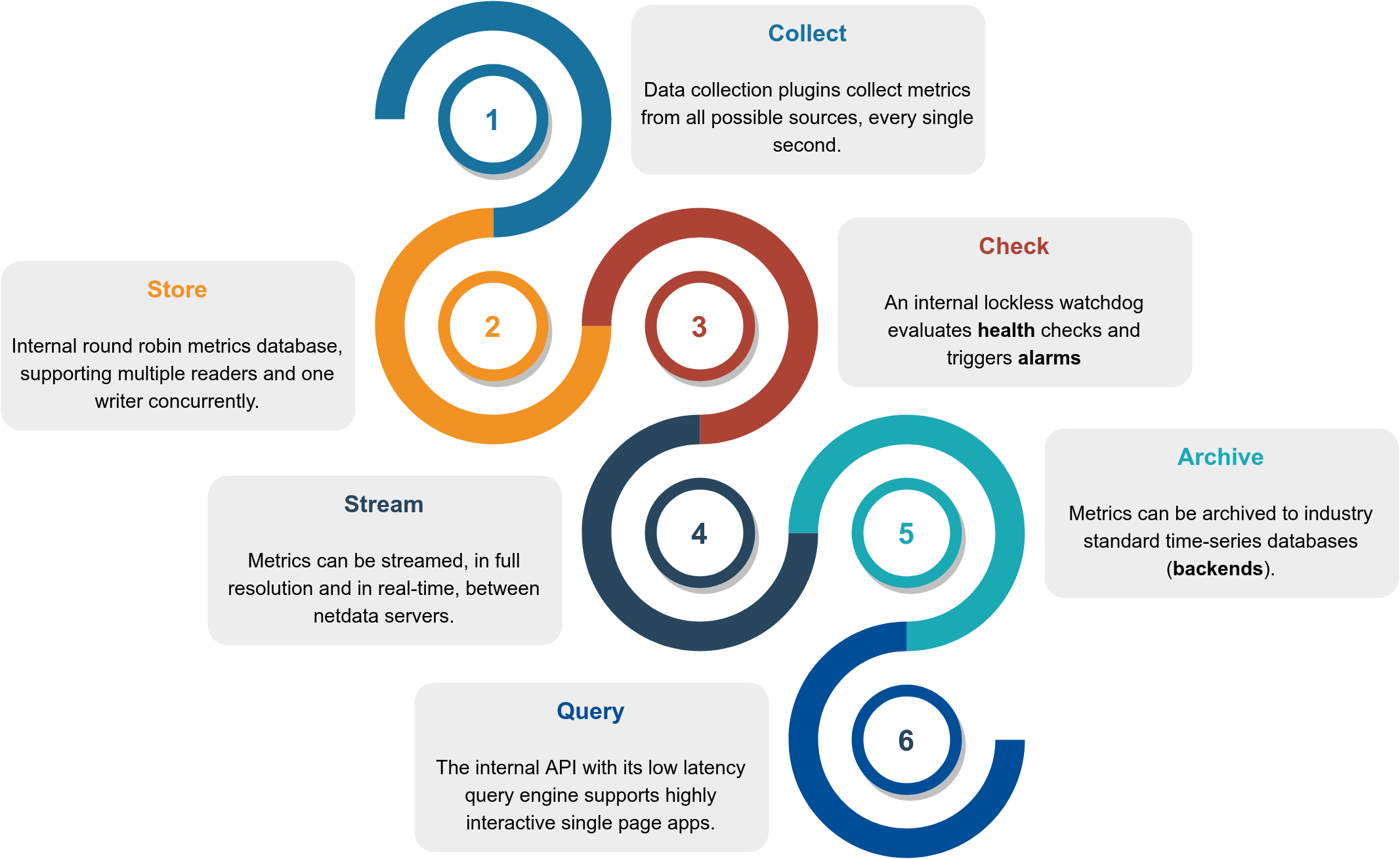 This is how it works: -|Function|Description|Documentation| -|:------:|:----------|:-----------:| -|**Collect**|Multiple independent data collection workers are collecting metrics from their sources using the optimal protocol for each application and push the metrics to the database. Each data collection worker has lockless write access to the metrics it collects.|[`collectors`](collectors/#data-collection-plugins)| -|**Store**|Metrics are first stored in RAM in a custom database engine that then "spills" historical metrics to disk for efficient long-term metrics storage.|[`database`](database/#database)| -|**Check**|A lockless independent watchdog is evaluating **health checks** on the collected metrics, triggers alarms, maintains a health transaction log and dispatches alarm notifications.|[`health`](health/#health-monitoring)| -|**Stream**|A lockless independent worker is streaming metrics, in full detail and in real-time, to remote Netdata servers, as soon as they are collected.|[`streaming`](streaming/#streaming-and-replication)| -|**Archive**|A lockless independent worker is down-sampling the metrics and pushes them to **backend** time-series databases.|[`backends`](backends/)| -|**Query**|Multiple independent workers are attached to the [internal web server](web/server/#web-server), servicing API requests, including [data queries](web/api/queries/#database-queries).|[`web/api`](web/api/#api)| +| Function | Description | Documentation | +| :---------- | :------------------------------------------------------------------------------------------------------------------------------------------------------------------------------------------------------------------------------------------------------------- | :-------------------------------------------------- | +| **Collect** | Multiple independent data collection workers are collecting metrics from their sources using the optimal protocol for each application and push the metrics to the database. Each data collection worker has lockless write access to the metrics it collects. | [`collectors`](collectors/README.md) | +| **Store** | Metrics are first stored in RAM in a custom database engine that then "spills" historical metrics to disk for efficient long-term metrics storage. | [`database`](database/README.md) | +| **Check** | A lockless independent watchdog is evaluating **health checks** on the collected metrics, triggers alarms, maintains a health transaction log and dispatches alarm notifications. | [`health`](health/README.md) | +| **Stream** | A lockless independent worker is streaming metrics, in full detail and in real-time, to remote Netdata servers, as soon as they are collected. | [`streaming`](streaming/README.md) | +| **Archive** | A lockless independent worker is down-sampling the metrics and pushes them to **backend** time-series databases. | [`backends`](backends/README.md) | +| **Query** | Multiple independent workers are attached to the [internal web server](web/server/README.md), servicing API requests, including [data queries](web/api/queries/README.md). | [`web/api`](web/api/README.md) | The result is a highly efficient, low-latency system, supporting multiple readers and one writer on each metric. ## Infographic -This is a high level overview of Netdata feature set and architecture. -Click it to to interact with it (it has direct links to our documentation). +This is a high level overview of Netdata feature set and architecture. Click it to to interact with it (it has direct +links to our documentation). [](https://my-netdata.io/infographic.html) @@ -262,28 +297,50 @@ This is what you should expect from Netdata: ### Health Monitoring & Alarms -- **Sophisticated alerting** - Netdata comes with hundreds of alarms **out of the box**! It supports dynamic thresholds, hysteresis, alarm templates, multiple role-based notification methods, and more. -- **Notifications**: [alerta.io](health/notifications/alerta/), [amazon sns](health/notifications/awssns/), [discordapp.com](health/notifications/discord/), [email](health/notifications/email/), [flock.com](health/notifications/flock/), [hangouts](health/notifications/hangouts/), [irc](health/notifications/irc/), [kavenegar.com](health/notifications/kavenegar/), [messagebird.com](health/notifications/messagebird/), [pagerduty.com](health/notifications/pagerduty/), [prowl](health/notifications/prowl/), [pushbullet.com](health/notifications/pushbullet/), [pushover.net](health/notifications/pushover/), [rocket.chat](health/notifications/rocketchat/), [slack.com](health/notifications/slack/), [smstools3](health/notifications/smstools3/), [syslog](health/notifications/syslog/), [telegram.org](health/notifications/telegram/), [twilio.com](health/notifications/twilio/), [web](health/notifications/web/) and [custom notifications](health/notifications/custom/). +- **Sophisticated alerting** - Netdata comes with hundreds of alarms **out of the box**! It supports dynamic + thresholds, hysteresis, alarm templates, multiple role-based notification methods, and more. +- **Notifications**: [alerta.io](health/notifications/alerta/), [amazon sns](health/notifications/awssns/), + [discordapp.com](health/notifications/discord/), [email](health/notifications/email/), + [flock.com](health/notifications/flock/), [hangouts](health/notifications/hangouts/), + [irc](health/notifications/irc/), [kavenegar.com](health/notifications/kavenegar/), + [messagebird.com](health/notifications/messagebird/), [pagerduty.com](health/notifications/pagerduty/), + [prowl](health/notifications/prowl/), [pushbullet.com](health/notifications/pushbullet/), + [pushover.net](health/notifications/pushover/), [rocket.chat](health/notifications/rocketchat/), + [slack.com](health/notifications/slack/), [smstools3](health/notifications/smstools3/), + [syslog](health/notifications/syslog/), [telegram.org](health/notifications/telegram/), + [twilio.com](health/notifications/twilio/), [web](health/notifications/web/) and [custom + notifications](health/notifications/custom/). ### Integrations -- **Time-series databases** - Netdata can archive its metrics to **Graphite**, **OpenTSDB**, **Prometheus**, **AWS Kinesis**, **MongoDB**, **JSON document DBs**, in the same or lower resolution (lower: to prevent it from congesting these servers due to the amount of data collected). Netdata also supports **Prometheus remote write API**, which allows storing metrics to **Elasticsearch**, **Gnocchi**, **InfluxDB**, **Kafka**, **PostgreSQL/TimescaleDB**, **Splunk**, **VictoriaMetrics** and a lot of other [storage providers](https://prometheus.io/docs/operating/integrations/#remote-endpoints-and-storage). +- **Time-series databases** - Netdata can archive its metrics to **Graphite**, **OpenTSDB**, **Prometheus**, **AWS + Kinesis**, **MongoDB**, **JSON document DBs**, in the same or lower resolution (lower: to prevent it from congesting + these servers due to the amount of data collected). Netdata also supports **Prometheus remote write API**, which + allows storing metrics to **Elasticsearch**, **Gnocchi**, **InfluxDB**, **Kafka**, **PostgreSQL/TimescaleDB**, + **Splunk**, **VictoriaMetrics** and a lot of other [storage + providers](https://prometheus.io/docs/operating/integrations/#remote-endpoints-and-storage). ## Visualization -- **Stunning interactive dashboards** - Our dashboard is mouse-, touchpad-, and touch-screen friendly in 2 themes: `slate` (dark) and `white`. -- **Amazingly fast visualization** - Even on low-end hardware, the dashboard responds to all queries in less than 1 ms per metric. -- **Visual anomaly detection** - Our UI/UX emphasizes the relationships between charts so you can better detect anomalies visually. -- **Embeddable** - Charts can be embedded on your web pages, wikis and blogs. You can even use [Atlassian's Confluence as a monitoring dashboard](web/gui/confluence/). +- **Stunning interactive dashboards** - Our dashboard is mouse-, touchpad-, and touch-screen friendly in 2 themes: + `slate` (dark) and `white`. +- **Amazingly fast visualization** - Even on low-end hardware, the dashboard responds to all queries in less than 1 ms + per metric. +- **Visual anomaly detection** - Our UI/UX emphasizes the relationships between charts so you can better detect + anomalies visually. +- **Embeddable** - Charts can be embedded on your web pages, wikis and blogs. You can even use [Atlassian's Confluence + as a monitoring dashboard](web/gui/confluence/). - **Customizable** - You can build custom dashboards using simple HTML. No JavaScript needed! ### Positive and negative values -To improve clarity on charts, Netdata dashboards present **positive** values for metrics representing `read`, `input`, `inbound`, `received` and **negative** values for metrics representing `write`, `output`, `outbound`, `sent`. +To improve clarity on charts, Netdata dashboards present **positive** values for metrics representing `read`, `input`, +`inbound`, `received` and **negative** values for metrics representing `write`, `output`, `outbound`, `sent`. 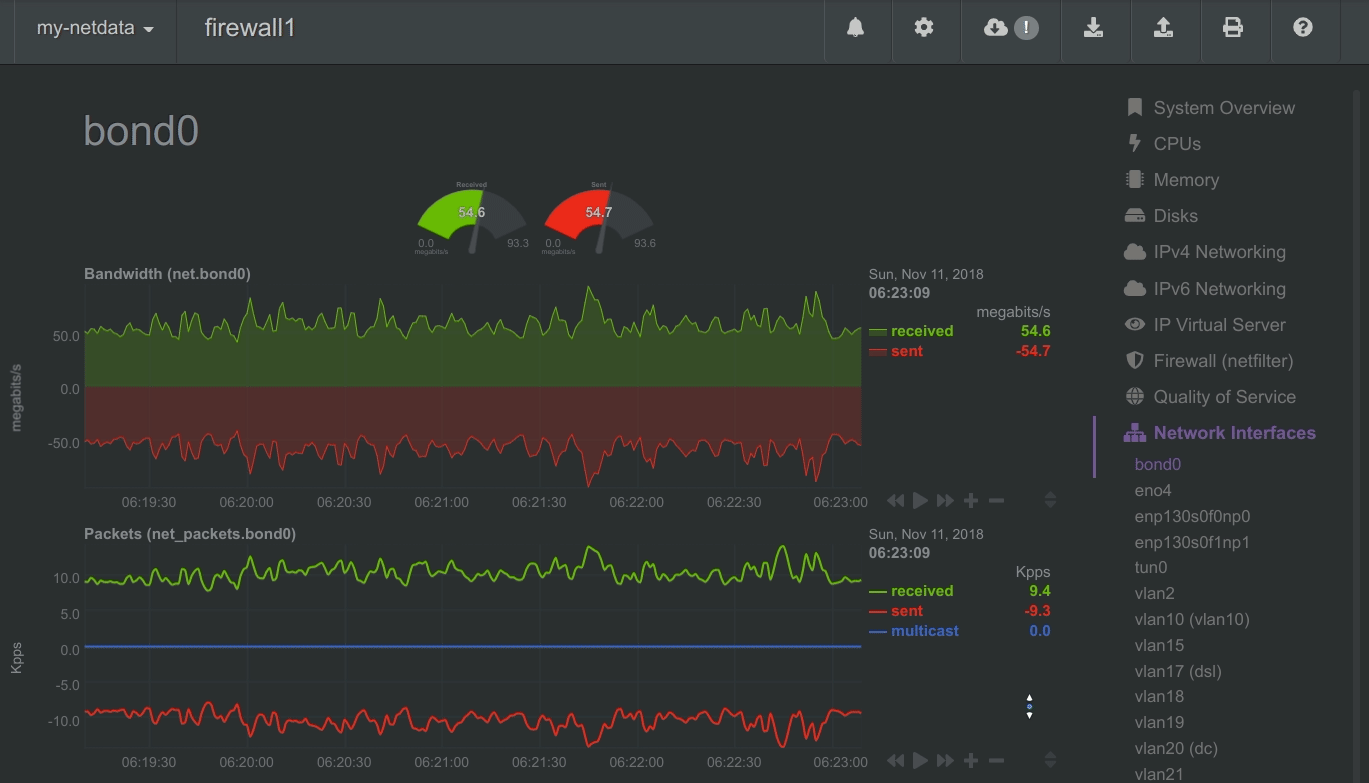 -_Netdata charts showing the bandwidth and packets of a network interface. `received` is positive and `sent` is negative._ +_Netdata charts showing the bandwidth and packets of a network interface. `received` is positive and `sent` is +negative._ ### Autoscaled y-axis @@ -291,43 +348,56 @@ Netdata charts automatically zoom vertically, to visualize the variation of each 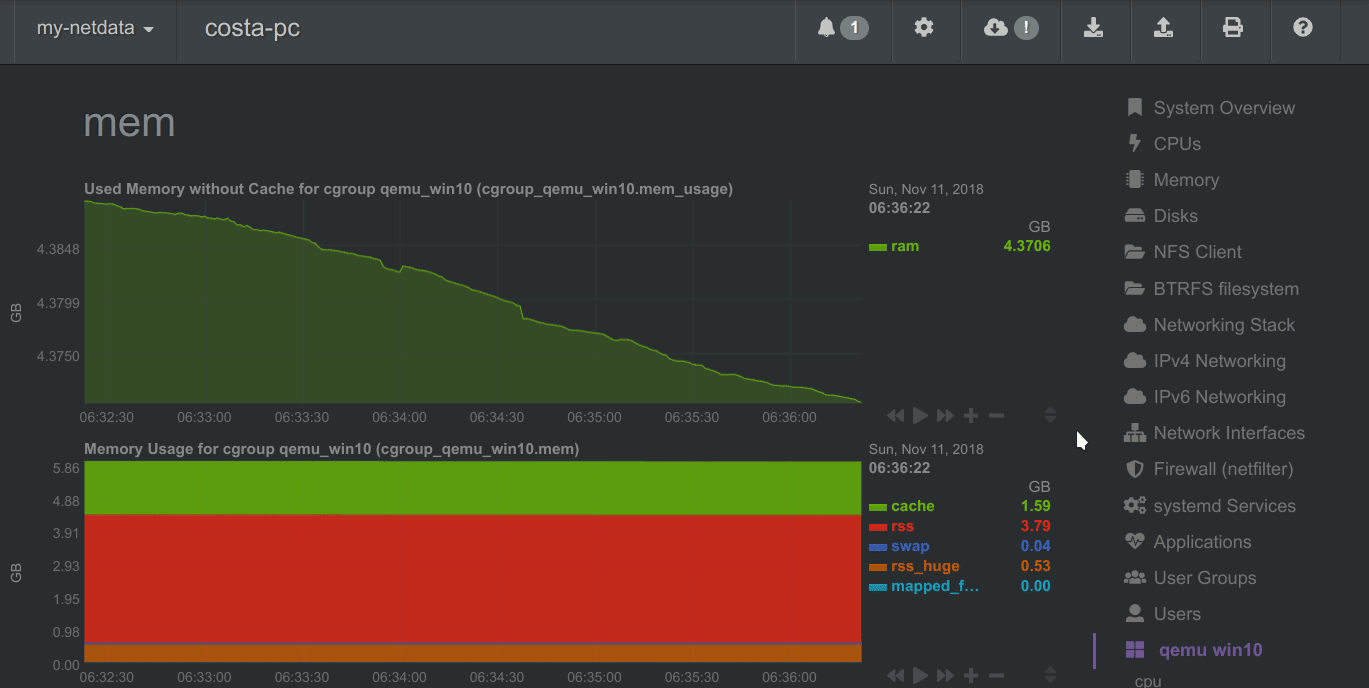 -_A zero-based `stacked` chart, automatically switches to an auto-scaled `area` chart when a single dimension is selected._ +_A zero-based `stacked` chart, automatically switches to an auto-scaled `area` chart when a single dimension is +selected._ ### Charts are synchronized -Charts on Netdata dashboards are synchronized to each other. There is no master chart. Any chart can be panned or zoomed at any time, and all other charts will follow. +Charts on Netdata dashboards are synchronized to each other. There is no master chart. Any chart can be panned or zoomed +at any time, and all other charts will follow. 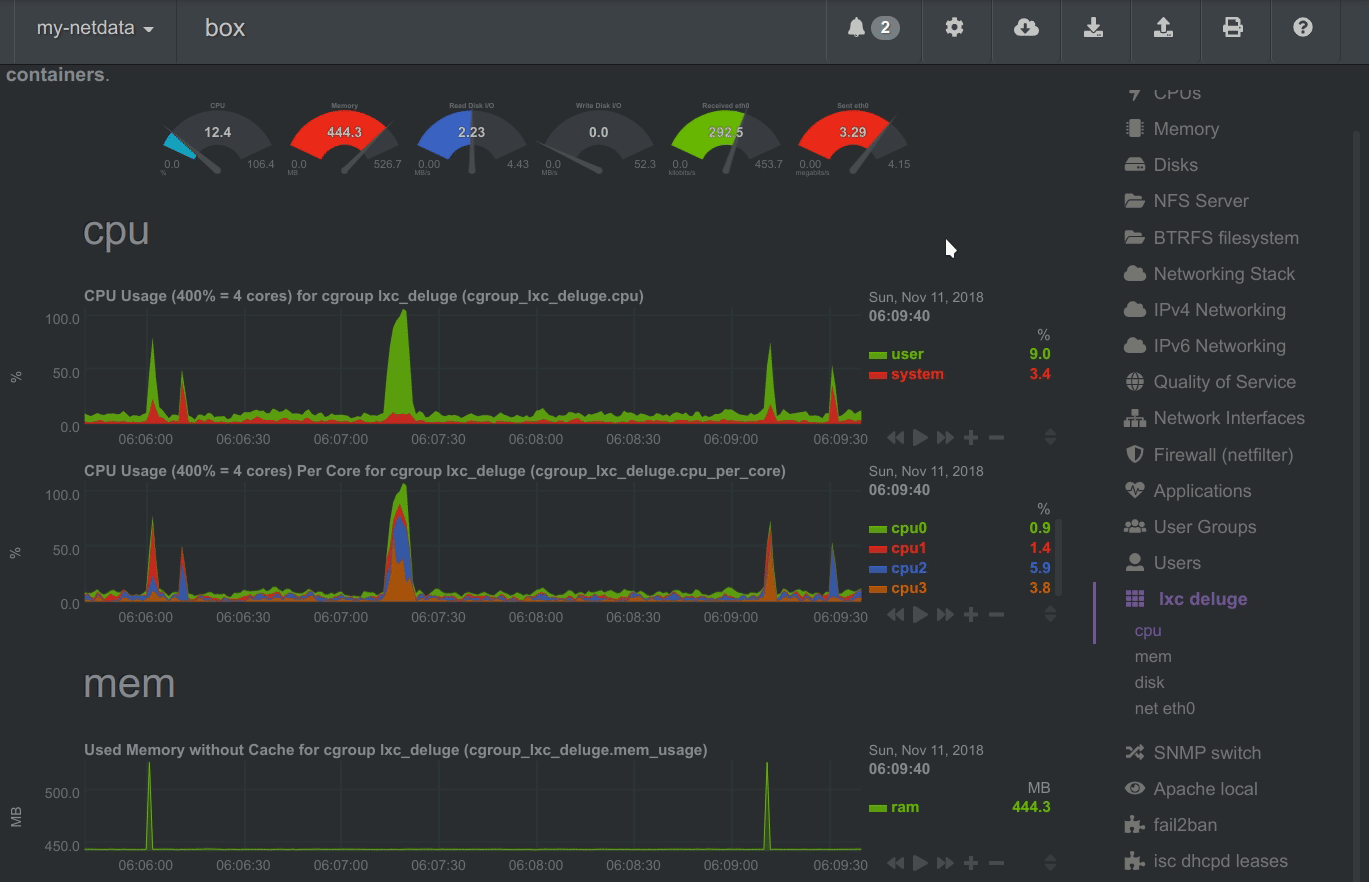 -_Charts are panned by dragging them with the mouse. Charts can be zoomed in/out with`SHIFT` + `mouse wheel` while the mouse pointer is over a chart._ +_Charts are panned by dragging them with the mouse. Charts can be zoomed in/out with`SHIFT` + `mouse wheel` while the +mouse pointer is over a chart._ -> The visible time-frame (pan and zoom) is propagated from Netdata server to Netdata server when navigating via the [node menu](registry#registry). +> The visible time-frame (pan and zoom) is propagated from Netdata server to Netdata server when navigating via the +> [My nodes menu](registry/README.md). ### Highlighted time-frame -To improve visual anomaly detection across charts, the user can highlight a time-frame (by pressing `Alt` + `mouse selection`) on all charts. +To improve visual anomaly detection across charts, the user can highlight a time-frame (by pressing `Alt` + `mouse +selection`) on all charts. 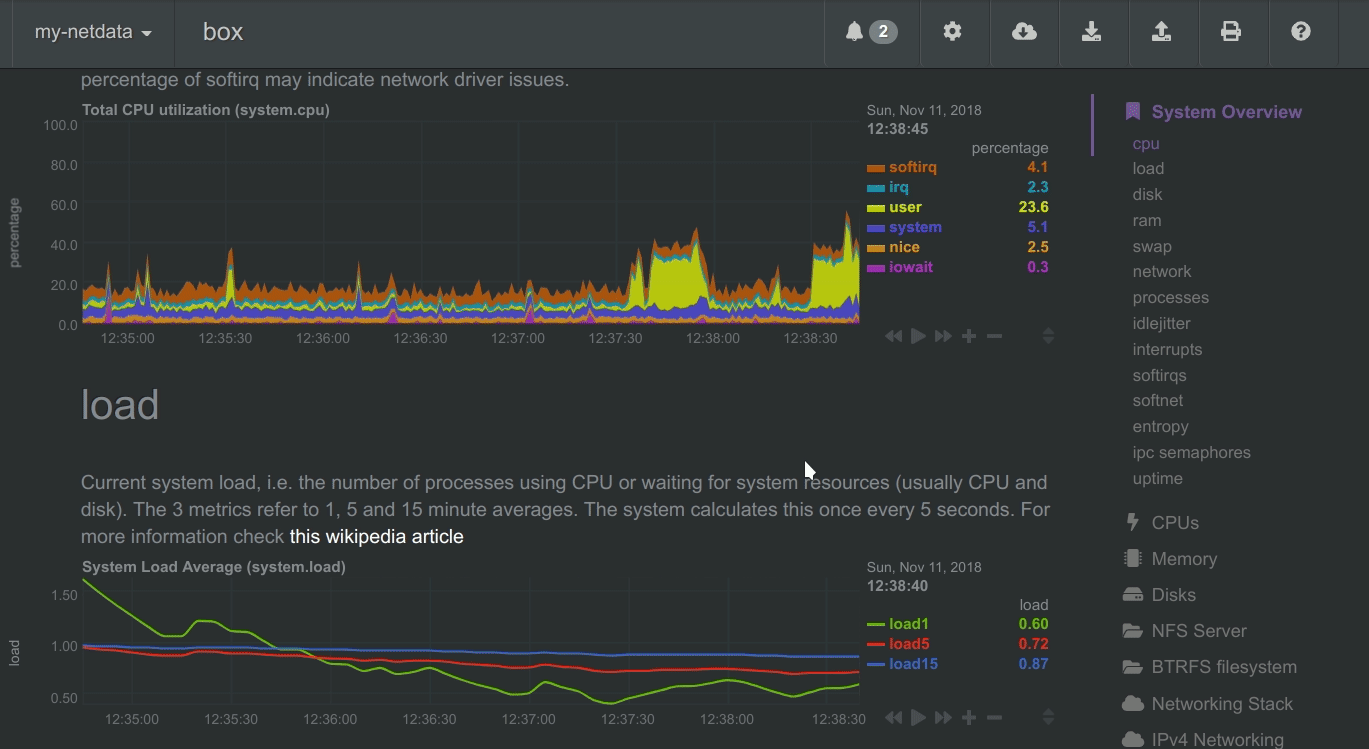 -_A highlighted time-frame can be given by pressing `Alt` + `mouse selection` on any chart. Netdata will highlight the same range on all charts._ +_A highlighted time-frame can be given by pressing `Alt` + `mouse selection` on any chart. Netdata will highlight the +same range on all charts._ -> Highlighted ranges are propagated from Netdata server to Netdata server, when navigating via the [node menu](registry#registry). +> Highlighted ranges are propagated from Netdata server to Netdata server, when navigating via the [My nodes +> menu](registry/README.md). ## What does it monitor -Netdata data collection is **extensible**. You can monitor anything you can get a metric for. Our [plugin API](collectors/plugins.d/) supports a variety of programming languages to make nearly anything a Netdata plugin: Go, Python, Node.js, Ruby, Java, Bash, Perl, and more! +Netdata data collection is **extensible**. You can monitor anything you can get a metric for. Our [plugin +API](collectors/plugins.d/) supports a variety of programming languages to make nearly anything a Netdata plugin: Go, +Python, Node.js, Ruby, Java, Bash, Perl, and more! -- For better performance, most system-related plugins (CPU, memory, disks, filesystems, networking, etc) have been written in C. -- For faster development and easier contributions, most application related plugins (databases, web servers, etc) have been written in Go and Python. +- For better performance, most system-related plugins (CPU, memory, disks, filesystems, networking, etc) have been + written in C. +- For faster development and easier contributions, most application related plugins (databases, web servers, etc) have + been written in Go and Python. -#### APM (Application Performance Monitoring) +### APM (Application Performance Monitoring) - **[statsd](collectors/statsd.plugin/)** - Netdata is a fully featured statsd server. -- **[Go expvar](collectors/python.d.plugin/go_expvar/)** - collects metrics exposed by applications written in the Go programming language using the expvar package. -- **[Spring Boot](collectors/python.d.plugin/springboot/)** - monitors running Java Spring Boot applications that expose their metrics with the use of the Spring Boot Actuator included in Spring Boot library. +- **[Go expvar](collectors/python.d.plugin/go_expvar/)** - collects metrics exposed by applications written in the Go + programming language using the expvar package. +- **[Spring Boot](collectors/python.d.plugin/springboot/)** - monitors running Java Spring Boot applications that + expose their metrics with the use of the Spring Boot Actuator included in Spring Boot library. - **[uWSGI](collectors/python.d.plugin/uwsgi/)** - collects performance metrics from uWSGI applications. -#### System Resources +### System Resources - **[CPU Utilization](collectors/proc.plugin/)** - total and per core CPU usage. - **[Interrupts](collectors/proc.plugin/)** - total and per core CPU interrupts. @@ -340,7 +410,7 @@ Netdata data collection is **extensible**. You can monitor anything you can get - **[Entropy](collectors/proc.plugin/)** - random numbers pool, using in cryptography. - **[Interprocess Communication - IPC](collectors/proc.plugin/)** - such as semaphores and semaphores arrays. -#### Memory +### Memory - **[ram](collectors/proc.plugin/)** - collects info about RAM usage. - **[swap](collectors/proc.plugin/)** - collects info about swap memory usage. @@ -353,7 +423,7 @@ Netdata data collection is **extensible**. You can monitor anything you can get - **[Numa](collectors/proc.plugin/)** - collects Numa info on systems that support it. - **[slab](collectors/proc.plugin/)** - collects info about the Linux kernel memory usage. -#### Disks +### Disks - **[block devices](collectors/proc.plugin/)** - per disk: I/O, operations, backlog, utilization, space, etc. - **[BCACHE](collectors/proc.plugin/)** - detailed performance of SSD caching devices. @@ -367,7 +437,7 @@ Netdata data collection is **extensible**. You can monitor anything you can get - **[adaptec_raid](collectors/python.d.plugin/adaptec_raid/)** - logical and physical devices health metrics. - **[ioping](collectors/ioping.plugin/)** - to measure disk read/write latency. -#### Filesystems +### Filesystems - **[BTRFS](collectors/proc.plugin/)** - detailed disk space allocation and usage. - **[Ceph](collectors/python.d.plugin/ceph/)** - OSD usage, Pool usage, number of objects, etc. @@ -375,9 +445,11 @@ Netdata data collection is **extensible**. You can monitor anything you can get - **[Samba](collectors/python.d.plugin/samba/)** - performance metrics of Samba SMB2 file sharing. - **[ZFS](collectors/proc.plugin/)** - detailed performance and resource usage. -#### Networking +### Networking -- **[Network Stack](collectors/proc.plugin/)** - everything about the networking stack (both IPv4 and IPv6 for all protocols: TCP, UDP, SCTP, UDPLite, ICMP, Multicast, Broadcast, etc), and all network interfaces (per interface: bandwidth, packets, errors, drops). +- **[Network Stack](collectors/proc.plugin/)** - everything about the networking stack (both IPv4 and IPv6 for all + protocols: TCP, UDP, SCTP, UDPLite, ICMP, Multicast, Broadcast, etc), and all network interfaces (per interface: + bandwidth, packets, errors, drops). - **[Netfilter](collectors/proc.plugin/)** - everything about the netfilter connection tracker. - **[SynProxy](collectors/proc.plugin/)** - collects performance data about the linux SYNPROXY (DDoS). - **[NFacct](collectors/nfacct.plugin/)** - collects accounting data from iptables. @@ -385,94 +457,118 @@ Netdata data collection is **extensible**. You can monitor anything you can get - **[FPing](collectors/fping.plugin/)** - to measure latency and packet loss between any number of hosts. - **[ISC dhcpd](collectors/python.d.plugin/isc_dhcpd/)** - pools utilization, leases, etc. - **[AP](collectors/charts.d.plugin/ap/)** - collects Linux access point performance data (`hostapd`). -- **[SNMP](collectors/node.d.plugin/snmp/)** - SNMP devices can be monitored too (although you will need to configure these). +- **[SNMP](collectors/node.d.plugin/snmp/)** - SNMP devices can be monitored too (although you will need to configure + these). - **[port_check](collectors/python.d.plugin/portcheck/)** - checks TCP ports for availability and response time. -#### Virtual Private Networks +### Virtual Private Networks - **[OpenVPN](collectors/python.d.plugin/ovpn_status_log/)** - collects status per tunnel. - **[LibreSwan](collectors/charts.d.plugin/libreswan/)** - collects metrics per IPSEC tunnel. - **[Tor](collectors/python.d.plugin/tor/)** - collects Tor traffic statistics. -#### Processes +### Processes - **[System Processes](collectors/proc.plugin/)** - running, blocked, forks, active. -- **[Applications](collectors/apps.plugin/)** - by grouping the process tree and reporting CPU, memory, disk reads, disk writes, swap, threads, pipes, sockets - per process group. +- **[Applications](collectors/apps.plugin/)** - by grouping the process tree and reporting CPU, memory, disk reads, + disk writes, swap, threads, pipes, sockets - per process group. - **[systemd](collectors/cgroups.plugin/)** - monitors systemd services using CGROUPS. -#### Users +### Users -- **[Users and User Groups resource usage](collectors/apps.plugin/)** - by summarizing the process tree per user and group, reporting: CPU, memory, disk reads, disk writes, swap, threads, pipes, sockets. +- **[Users and User Groups resource usage](collectors/apps.plugin/)** - by summarizing the process tree per user and + group, reporting: CPU, memory, disk reads, disk writes, swap, threads, pipes, sockets. - **[logind](collectors/python.d.plugin/logind/)** - collects sessions, users and seats connected. -#### Containers and VMs +### Containers and VMs -- **[Containers](collectors/cgroups.plugin/)** - collects resource usage for all kinds of containers, using CGROUPS (systemd-nspawn, lxc, lxd, docker, kubernetes, etc). +- **[Containers](collectors/cgroups.plugin/)** - collects resource usage for all kinds of containers, using CGROUPS + (systemd-nspawn, lxc, lxd, docker, kubernetes, etc). - **[libvirt VMs](collectors/cgroups.plugin/)** - collects resource usage for all kinds of VMs, using CGROUPS. - **[dockerd](collectors/python.d.plugin/dockerd/)** - collects docker health metrics. -#### Web Servers +### Web Servers -- **[Apache and lighttpd](collectors/python.d.plugin/apache/)** - `mod-status` (v2.2, v2.4) and cache log statistics, for multiple servers. +- **[Apache and lighttpd](collectors/python.d.plugin/apache/)** - `mod-status` (v2.2, v2.4) and cache log statistics, + for multiple servers. - **[IPFS](collectors/python.d.plugin/ipfs/)** - bandwidth, peers. - **[LiteSpeed](collectors/python.d.plugin/litespeed/)** - reads the litespeed rtreport files to collect metrics. - **[Nginx](collectors/python.d.plugin/nginx/)** - `stub-status`, for multiple servers. -- **[Nginx+](collectors/python.d.plugin/nginx_plus/)** - connects to multiple nginx_plus servers (local or remote) to collect real-time performance metrics. -- **[PHP-FPM](collectors/python.d.plugin/phpfpm/)** - multiple instances, each reporting connections, requests, performance, etc. +- **[Nginx+](collectors/python.d.plugin/nginx_plus/)** - connects to multiple nginx_plus servers (local or remote) to + collect real-time performance metrics. +- **[PHP-FPM](collectors/python.d.plugin/phpfpm/)** - multiple instances, each reporting connections, requests, + performance, etc. - **[Tomcat](collectors/python.d.plugin/tomcat/)** - accesses, threads, free memory, volume, etc. -- **[web server `access.log` files](collectors/python.d.plugin/web_log/)** - extracting in real-time, web server and proxy performance metrics and applying several health checks, etc. -- **[HTTP check](collectors/python.d.plugin/httpcheck/)** - checks one or more web servers for HTTP status code and returned content. +- **[web server `access.log` files](collectors/python.d.plugin/web_log/)** - extracting in real-time, web server and + proxy performance metrics and applying several health checks, etc. +- **[HTTP check](collectors/python.d.plugin/httpcheck/)** - checks one or more web servers for HTTP status code and + returned content. -#### Proxies, Balancers, Accelerators +### Proxies, Balancers, Accelerators - **[HAproxy](collectors/python.d.plugin/haproxy/)** - bandwidth, sessions, backends, etc. -- **[Squid](collectors/python.d.plugin/squid/)** - multiple servers, each showing: clients bandwidth and requests, servers bandwidth and requests. -- **[Traefik](collectors/python.d.plugin/traefik/)** - connects to multiple traefik instances (local or remote) to collect API metrics (response status code, response time, average response time and server uptime). +- **[Squid](collectors/python.d.plugin/squid/)** - multiple servers, each showing: clients bandwidth and requests, + servers bandwidth and requests. +- **[Traefik](collectors/python.d.plugin/traefik/)** - connects to multiple traefik instances (local or remote) to + collect API metrics (response status code, response time, average response time and server uptime). - **[Varnish](collectors/python.d.plugin/varnish/)** - threads, sessions, hits, objects, backends, etc. - **[IPVS](collectors/proc.plugin/)** - collects metrics from the Linux IPVS load balancer. -#### Database Servers - -- **[CouchDB](collectors/python.d.plugin/couchdb/)** - reads/writes, request methods, status codes, tasks, replication, per-db, etc. -- **[MemCached](collectors/python.d.plugin/memcached/)** - multiple servers, each showing: bandwidth, connections, items, etc. -- **[MongoDB](collectors/python.d.plugin/mongodb/)** - operations, clients, transactions, cursors, connections, asserts, locks, etc. -- **[MySQL and mariadb](collectors/python.d.plugin/mysql/)** - multiple servers, each showing: bandwidth, queries/s, handlers, locks, issues, tmp operations, connections, binlog metrics, threads, innodb metrics, and more. -- **[PostgreSQL](collectors/python.d.plugin/postgres/)** - multiple servers, each showing: per database statistics (connections, tuples read - written - returned, transactions, locks), backend processes, indexes, tables, write ahead, background writer and more. +### Database Servers + +- **[CouchDB](collectors/python.d.plugin/couchdb/)** - reads/writes, request methods, status codes, tasks, + replication, per-db, etc. +- **[MemCached](collectors/python.d.plugin/memcached/)** - multiple servers, each showing: bandwidth, connections, + items, etc. +- **[MongoDB](collectors/python.d.plugin/mongodb/)** - operations, clients, transactions, cursors, connections, + asserts, locks, etc. +- **[MySQL and mariadb](collectors/python.d.plugin/mysql/)** - multiple servers, each showing: bandwidth, queries/s, + handlers, locks, issues, tmp operations, connections, binlog metrics, threads, innodb metrics, and more. +- **[PostgreSQL](collectors/python.d.plugin/postgres/)** - multiple servers, each showing: per database statistics + (connections, tuples read - written - returned, transactions, |
